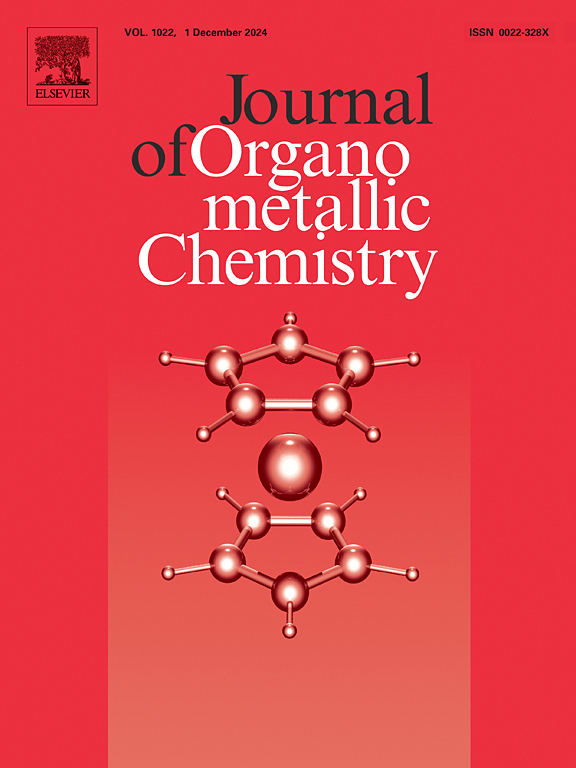配位多样性:Co, Fe, Mn和Sn的多氮给体胍类配合物的合成和表征
IF 2.1
3区 化学
Q3 CHEMISTRY, INORGANIC & NUCLEAR
引用次数: 0
摘要
将二环己基碳二酰亚胺(DCC)或二异丙基碳二酰亚胺(DIC)亲核加入到含TMS-Apy/Apy的锂酰胺中,然后与不同的金属氯化物反应,得到具有不同配位模式的配合物。与CoCl2或FeCl2反应得到含胍的不对称1,3,5 -三氮五烯配体配合物[{CyNC{N(H)Cy}NPy}2Co](1)、[{CyNC{N(SiMe3)Cy}NPy}2Co] (2a)和[{CyNC{N(SiMe3)Cy}NPy}2Fe] (2b)。与MnCl2反应生成具有酰胺和胍两种结构的Li-Mn双金属配合物[{CyNC{N(SiMe3)Cy}NPy}3LiMn](3)。此外,在碳二亚胺插入锂酰胺时,通常会发生1,3 - sime3 /-H迁移。然而,当DIC用于亲核加成,然后与SnCl2反应时,只得到一个没有-SiMe3移位的四配位胍配合物[{iPrNC(NiPr)N{(SiMe3)Py}}2Sn](4)。本文章由计算机程序翻译,如有差异,请以英文原文为准。

Coordination diversity: Synthesis and characterization of guanidinate complexes of Co, Fe, Mn, and Sn with multi-nitrogen donors
Dicyclohexylcarbodiimide (DCC) or diisopropylcarbodiimide (DIC) was nucleophilically added to lithium amides containing TMS-Apy/Apy, and then further reacted with different metal chlorides to obtain complexes with various coordination modes. Reaction with CoCl2 or FeCl2 led to guanidinate-containing unsymmetric 1, 3, 5-triazapentadiene ligands complexes [{CyNC{N(H)Cy}NPy}2Co] (1), [{CyNC{N(SiMe3)Cy}NPy}2Co] (2a), and [{CyNC{N(SiMe3)Cy}NPy}2Fe] (2b). Reaction with MnCl2 yielded a Li-Mn bimetallic complex [{CyNC{N(SiMe3)Cy}NPy}3LiMn] (3) with both amidinate and guanidinate structures. Additionally, a 1, 3-SiMe3/-H migration usually occurs during the insertion of carbodiimide into lithium amide. However, when DIC was used for nucleophilic addition and followed by a reaction with SnCl2, only a four-coordinated guanidinate complex [{iPrNC(NiPr)N{(SiMe3)Py}}2Sn] (4) without -SiMe3 shift was obtained.
求助全文
通过发布文献求助,成功后即可免费获取论文全文。
去求助
来源期刊

Journal of Organometallic Chemistry
化学-无机化学与核化学
CiteScore
4.40
自引率
8.70%
发文量
221
审稿时长
36 days
期刊介绍:
The Journal of Organometallic Chemistry targets original papers dealing with theoretical aspects, structural chemistry, synthesis, physical and chemical properties (including reaction mechanisms), and practical applications of organometallic compounds.
Organometallic compounds are defined as compounds that contain metal - carbon bonds. The term metal includes all alkali and alkaline earth metals, all transition metals and the lanthanides and actinides in the Periodic Table. Metalloids including the elements in Group 13 and the heavier members of the Groups 14 - 16 are also included. The term chemistry includes syntheses, characterizations and reaction chemistry of all such compounds. Research reports based on use of organometallic complexes in bioorganometallic chemistry, medicine, material sciences, homogeneous catalysis and energy conversion are also welcome.
The scope of the journal has been enlarged to encompass important research on organometallic complexes in bioorganometallic chemistry and material sciences, and of heavier main group elements in organometallic chemistry. The journal also publishes review articles, short communications and notes.
 求助内容:
求助内容: 应助结果提醒方式:
应助结果提醒方式:


